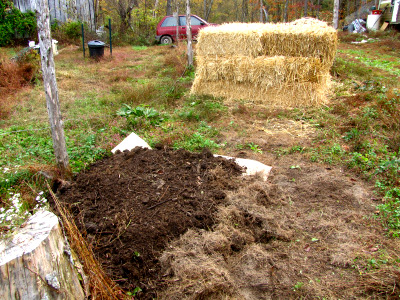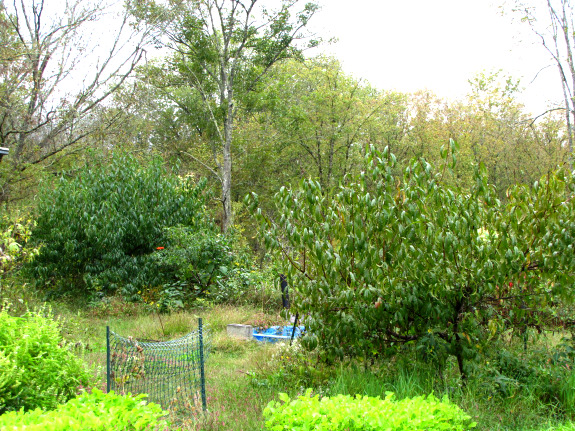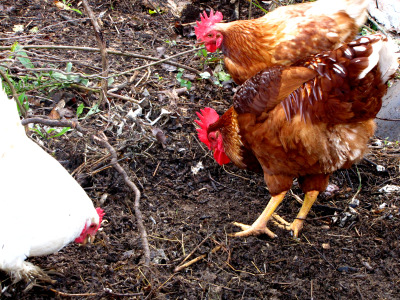
A $20 mound
 Every
year, I splurge and spend a hundred bucks on new perennials.
Although it seems like a lot of cash, fruit trees take a long time to
mature and it just makes sense to find the money to sink into long term
farm infrastructure as soon as possible.
Every
year, I splurge and spend a hundred bucks on new perennials.
Although it seems like a lot of cash, fruit trees take a long time to
mature and it just makes sense to find the money to sink into long term
farm infrastructure as soon as possible.
This year, Mark talked
me into spending even more on perennials since
we've got several gaps in the forest garden, remnants of the days when
I didn't realize that there is
no point in planting fruit trees in the
waterlogged soil without raising them up on significant mounds and that I should plant
disease resistant varieties rather than just my favorite foods.
So I put in an order for Liberty and
old-fashioned Winesap apples, Redhaven and Cresthaven peaches, Prima
and Bounty Almonds, Carpathian walnuts (to go in the
other forest
garden where there's
room for mammoths), timber bamboo, dwarf Korean
nut
pine, and Chicago hardy fig.

The old saw admonishes
us to dig a $10 hole for a $2 tree, and I'm now
a firm believer in every part of the saying except the hole part.
Take a look at the photos above, and you'll probably become a believer
too. The peach on the left was planted on a large mound of rich
soil that I expanded over the next two years by piling garden weeds
around the mound edges. That peach gave us a glut of
delicious
peaches this
year. The peach on the right was planted one year
later on a much smaller mound that was never expanded. It gave us
four peaches this year, and its leaves have always been a yellowish
color instead of the vibrant green of the peach planted in a $10
mound. The dark green peach is actually 25 feet further away from
the camera, but it looks nearly as big as the yellow peach, doesn't it?
In actuality, our happy peach is about twice as big around.
I've learned my lesson
and have resolved to plant this year's perennials in $20 mounds.
After laying down a sheet of cardboard to kill
vigorous weeds, I hauled four wheelbarrow loads of composted weeds from
the forest pasture, then topped the mound with a  wheelbarrow
load of
the world's
best wood chip mulch.
Unfortunately, I ran out of the prime composted weeds after mound
number three, so I need to come up with some other awesome soil to
build the other half of the mounds.
wheelbarrow
load of
the world's
best wood chip mulch.
Unfortunately, I ran out of the prime composted weeds after mound
number three, so I need to come up with some other awesome soil to
build the other half of the mounds.
As a side note, the
chickens were just as helpful when it came time to shovel compost as
when I was shovelling wood chips. I was impressed to see how well
our merged flock plays together now that the
rooster has taken all of the biddies under his wing. Just a week
ago, our broody hen would never have let the loner forage so close to
her sharp, sharp beak.
Want more in-depth information? Browse through our books.
Or explore more posts by date or by subject.
About us: Anna Hess and Mark Hamilton spent over a decade living self-sufficiently in the mountains of Virginia before moving north to start over from scratch in the foothills of Ohio. They've experimented with permaculture, no-till gardening, trailersteading, home-based microbusinesses and much more, writing about their adventures in both blogs and books.
Want to be notified when new comments are posted on this page? Click on the RSS button after you add a comment to subscribe to the comment feed, or simply check the box beside "email replies to me" while writing your comment.

You hadn't told me that before, but I'd read that somewhere on the internet. I also read a lot of rebuttals from folks who believed that it wasn't the species of nuts, but instead factors of processing and/or storage. (I can't remember the specifics.) I'm willing to chance it since I've discovered that most of the bad tastes out there aren't present in homegrown produce. I used to hate half of the things I now grow --- they just taste so much better fresh!
Of course, you should feel free to say "I told you so" in a decade or two.